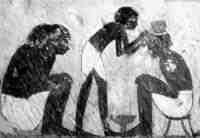Ancient African Medicine’s Blueprint for Modern Healthcare

Ancient African Neurosurgery Wiki Commons http://www.esns.org.eg/history.htm)
Ancient African Medicine: The Unsung Blueprint of Modern Healthcare
Long before the first hospitals, African communities were practicing medicine with remarkable sophistication. Healers were surgeons, pharmacists, and public health practitioners rolled into one. Their knowledge of plants, the human body, and disease prevention shaped the very foundations of modern healthcare—and the world is only beginning to acknowledge this legacy.
Surgery Before Scalpels
Did you know that skull surgery, or trepanation, was being performed in Africa more than 13,000 years ago? Archaeologists have found skulls in North and East Africa showing carefully made openings, with signs of healing that prove patients often survived. Fast forward to ancient Egypt, and we find detailed surgical manuals like the Edwin Smith Papyrus (c. 1600 BCE) and the Ebers Papyrus (c. 1550 BCE). These documents outlined how to treat fractures, dress wounds with honey, stitch up injuries, and even manage parasitic infections like Guinea worm. Many of these methods are still in use in some form today.
Centuries later, in Uganda, the Banyankole people were performing caesarean sections in the 19th century using banana wine as both antiseptic and anesthetic. Scottish explorer R.W. Felkin famously documented the procedure and marveled at the level of skill involved. In West Africa, Yoruba and Igbo bone-setters became renowned for their ability to treat fractures with splints and immobilization techniques now mirrored in orthopedics. Traditional bone-setting practices are still found in Africa today, in Ghana and Nigeria.
Africa’s flora has also given the world life-saving medicines. Take the Calabar bean from Nigeria: once used in spiritual rituals, it led to the discovery of physostigmine, a compound used to treat glaucoma and certain poisonings. The bark of Prunus africana, long used to ease urinary problems, is now processed into standardized extracts for prostate health. In Southern Africa, Devil’s claw (Harpagophytum procumbens) is prized for its anti-inflammatory powers and is widely used in Europe for arthritis and back pain. Pelargonium sidoides, known locally as Umckaloabo, inspired the cough and cold remedy EPs 7630, sold worldwide. And compounds like combretastatins from the South African bushwillow tree are showing promise as cancer treatments.
African healers have always understood that prevention is as important as cure. During outbreaks, communities fumigated homes with aromatic herbs or isolated infected individuals—concepts modern public health still relies on. Their holistic approach, which treats mind, body, and spirit as one, is increasingly reflected in today’s integrative medicine. As the World Health Organization acknowledges, traditional knowledge is essential to creating inclusive, accessible healthcare systems.
Africa’s medicinal plants and indigenous knowledge are under threat. Species like Prunus africana and Warburgia salutaris are endangered because of overharvesting, and the commercialization of plant-based drugs often leaves local communities with little benefit. Protecting these resources isn’t just about saving trees—it’s about safeguarding centuries of wisdom. African traditional medicine isn’t a relic of the past; it’s a living, evolving system. It gave the world surgical techniques, public health strategies, and plant-based drugs that have saved millions of lives. As researchers continue to tap into Africa’s rich ethnobotanical heritage, the call for ethical partnerships and conservation has never been louder. Africa’s healers laid the groundwork for global healthcare. Recognizing and preserving their knowledge is not just a matter of history—it’s a blueprint for the future.
References
- Breasted, J.H. (1930). The Edwin Smith Surgical Papyrus. University of Chicago Press.
- Nunn, J.F. (1996). Ancient Egyptian Medicine. British Museum Press.
- Felkin, R.W. (1884). Notes on labour in Central Africa. Edinburgh Medical Journal, 25, 922–930.
- Ogunlusi, J.D., et al. (2007). Traditional bone setting and splinting techniques in Nigeria. Tropical Doctor, 37(3), 186–187.
Recommended: Food as Medicine
